Playable characters:
64: 01–04 (Starting Roster 1) | 05–08 (Starting Roster 2) | 09–12 (Unlockable Fighters)
Melee: 13–17 (Starting Newcomers) | 18–22 (Unlockable Fighters 1) | 23–26 (Unlockable Fighters 2)
Brawl: 27–31 (E3 2006) | 32–39 (Smash Bros. DOJO!! 2007) | 40–44 (Smash Bros. DOJO!! 2008)
For 3DS and Wii U: 45–49 (Pre-Smash Direct) | 50–55 (Smash Direct and E3 2014) | 56–59 (Remaining Roster) | 60–63 (DLC Fighters)
Ultimate: 64–69 (Initial Release) | New Echo Fighters | 70–75 (DLC Fighters 1) | 76–82 (DLC Fighters 2)
Mii Costumes
Individual Characters: Joker | Sephiroth
Non-playable characters:
Poké Ball Pokémon | Assist Trophies | Enemies | Bosses | Stage Characters | Others
This page lists all the notable non-playable characters in the Super Smash Bros. series, such as sentient items and summoned characters. Beware of spoilers.
Items
64

An enemy from the Super Mario Bros. franchise. Bob-ombs are living bombs that walk around and explode when they see Mario. In Super Smash Bros., they act as items that can be thrown at others for massive damage.
- Action Bomb: They're used as hand-thrown bombs, and if not picked up within a set amount of time they'll start walking around on their own before exploding.
- Cartoon Bomb: They're classic shiny black spheres with a short wick on top.
- Death from Above: When Sudden Death matches drag on for too long, Bob-ombs rain from the sky to speed things along. This also happens in certain Spirit Battles, where they will rain down a lot more frequently.
Melee
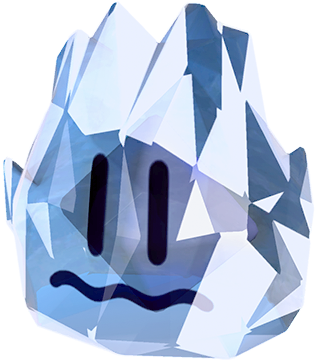
An enemy from way back in Mario and Luigi's plumber days. These blocks of ice would break apart on the platforms, coating them in thick layers of ice if they weren't stopped. They appear as items and can be thrown at opponents to freeze them.
- An Ice Person: Obviously. They freeze players solid on contact.
- Animate Inanimate Object: It's just a chunk of ice with a face on it. It's unknown if it's sentient, but since it's classified as an enemy in its home series...
- Elemental Embodiment: A living chunk of ice.

Strange denizens of Saturn Valley in Eagleland, though their home can also be found on the Nowhere Islands. Despite their lack of arms, they're surprisingly skilled in developing technology. In Smash Bros., they can be tossed at enemies for seemingly minimal effect, but you'd be surprised what it's capable of.
- Ambiguous Gender: There's not much of a way to determine what Mr. Saturn's gender is, despite the bows on their heads and the fact that they have "Mr." in front of their name.
- Grievous Harm with a Body: Throwing them is the only thing you can really do with them.
- Lethal Joke Character: Even though it exists as an item mostly for laughs, it can break shields incredibly easily, its minimal knockback makes it great for combos, and it takes quite a while for it to disappear.

A sandbag. The aim of the Home-Run Contest mode is to launch him as far as possible. In Brawl onward, you can knock items out of him or practice on him during online intermissions.
- Animate Inanimate Object: Sandbag can move on his own, but it's very rare. In Ultimate, he'll occasionally smile.
- Ascended Extra: In Brawl, he makes it to the battlefield proper... as an item.
- Black Bead Eyes: Look painted on, until he blinks.
- The Chew Toy: His whole reason to exist is to be beaten senseless by the playable characters. Not that he cares. In fact, he enjoys being beaten up and launched. This was the main point of his appearance in, fittingly enough, Little Mac's trailer.
- Demoted to Extra: The absence of Home-Run Contest in the base game for Ultimate was seen as this for him. He still appeared as an item, but the mode that, in a way, focused on him was gone. Thankfully subverted as of the 5.0.0 update.
- Feel No Pain: According to his trophies in Melee and Brawl, he doesn't feel pain at all. Which explains why he doesn't mind getting wailed on so much. The 3DS/Wii U trophy even says that it would almost be mean to not beat the pulp out of it. Finally explicitly shown in Ultimate, where he looks downright blissful if you beat him hard enough.
- Invincible Minor Minion: In Brawl, K.O.ing (or swallowing) him during online intermissions causes him to respawn in the middle of the stage. In Melee, he cannot be K.O'd, period.note
- No-Sell: In Brawl and 3DS/Wii U, he cannot be grappled, presumably so pummels can't be used to easily rack up its damage.
- Piñata Enemy: In his appearances as an item from Brawl onward, hitting Sandbag causes him to occasionally dispense food and items.
- Ridiculously Cute Critter: It almost makes you feel bad for beating on him... almost.
- Throw the Dog a Bone: In Ultimate, Sandbag's eyes arc with a joyful expression if he's left alone for a while without being hurt.
- Too Kinky to Torture: On the other hand, Sandbag will blush when hit in Ultimate's Home Run Contest. Beating the absolute snot out of him adds to the blush by closing his eyes and filling his eyelashes with sparkles in a blissful-like expression, so it's not really clear if Sandbag enjoys being hurt or the opposite.
- Training Dummy: Essentially a living punching bag, though he isn't actually used as such in the games' Training Modes unless you summon the item form of Sandbag. However, he fits the part mechanically, since he doesn't fight back and suffers knockback like everyone else.
Brawl
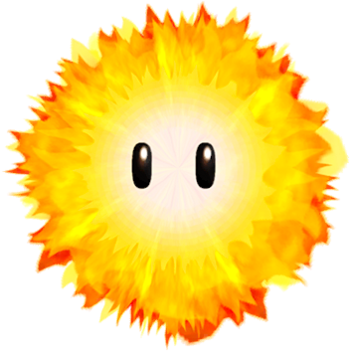
A larger version of the Li'l Sparky enemy. It and its smaller cousin would move across platforms and serve as obstacles for Mario and friends to avoid. In Smash Bros., they circle the platforms they're thrown onto and hurt anyone in their path. They can also absorb certain projectiles.
- Art Evolution: In Brawl, Hotheads have very smoothly circular designs with yellow cores, orange rims, and flames and motes of fire floating around their edges. The fourth game gives them a general redesign that removes the distinction between their cores and rims as well as the external flame effects, and which modifies their edges to look like they're made up of multiple flickering flames instead of being smooth balls of energy.
- Attackable Pickup: Striking a Hothead before it is picked up will cause it to grow bigger.
- Depending on the Writer: Hotheads and Li'l Sparkies are typically balls of energy, but what element they are is varied. Watt from Paper Mario 64 uses electricity, while these Hotheads also deal fire damage.
- Elemental Embodiment: They're living Fireballs.
- Energy Absorption: Any non-physical projectile that hits it makes it bigger and allows it to do a great deal more damage.
- One-Hit Kill: After absorbing enough projectiles, they become strong enough to instantly KO anyone they hit. In Brawl, they automatically become able to do this in the last few seconds they're in play.
- Playing with Fire: They deal fire damage, and are themselves powered up by fire.
- Shock and Awe: After being thrown, they periodically release electrical bolts.
- Took a Level in Badass: Ultimate gives them a hefty amount of buffs. Unlike in earlier games, where they only "feed" off of fire and electriciy, any damaging attack increases their size; in addition, they turn directions if they roll offscreen on a surface that endlessly goes towards a blast line and can roll on wheeled crates.

An urchin that serves as the main enemy for the blowfish, Bubbles, as she tries to retrieve the golden ingots from their clutches. They serve as items, extending their spikes when thrown onto a stable surface.
- Ceiling Cling: They can even stick to walls and ceilings.
- Sea Hurtchin: These urchins stay in one place just waiting for a fighter to get hurt on their spines. They don't even look like real-life sea urchins so much as perfect spheres studded with conical spikes.
- Spikes of Villainy: They're the main antagonistic force of Clu Clu Land and very, very spiky.
3DS/Wii U
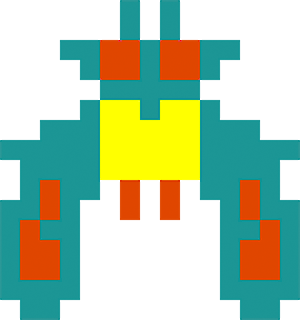
The strongest of the space bugs from Galaga, these creatures have a strong tractor beam that they've used to capture many players' ships in the past. Now, they can be seen doing the same thing in Super Smash Bros.
- Attackable Pickup: Striking it before it is picked up will cause it to turn a different color.
- Retraux: It's always seen as a simple sprite. It also uses sound effects from its game of origin.
- Tractor Beam: It uses this to screen-KO fighters.

Chicken-like creatures that have appeared in many of Link's adventures through the ages. They're normally harmless, but attacking them too much will cause them to cry out for its brethren to attack the provoker. They appear as an item in Smash Bros. where they do just that, but you can also throw them at enemies to incite their wrath on them.
- Grievous Harm with a Body: You can throw Cuccos at other enemies to sic them on your opponents. Odd, considering their tendency to attack anyone who wishes to harm it.
- Killer Rabbit: A seemingly harmless chicken. Whatever you do, do not attack it by mistake.

A tiny fairy in a bottle. These tiny creatures have assisted Link since the very beginning, healing him for massive amounts of health and even bringing him back from the brink of death when kept inside an Empty Bottle. In Smash Bros., they don't do anything until a fighter's damage percentage is 100% or more, healing just that much when someone with that percentage picks it up.
- Back from the Brink: Fairies can only heal damage when the one who needs healing is at 100% damage of more, saving them from a surefire loss.
- Fairy in a Bottle: The item takes the form of a glass bottle holding a small Spark Fairy, which will heal you when the bottle opens.
- Spark Fairy: The fairy held inside the bottle resembles a small mote of light with insect wings.
Ultimate
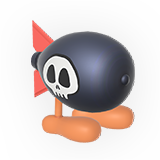
An enemy from the Kirby series that explodes when it falls. Inhaling it would give Kirby the Crash ability. In Ultimate, this ability can be used on enemies.
- Action Bomb: They're walking nukes on legs that amble around the battlefield for a while before exploding.
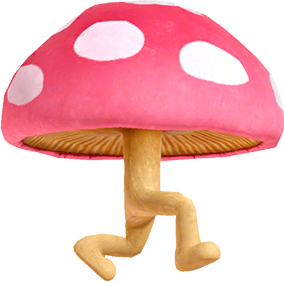
A peculiar enemy that Ness and co. tend to encounter. When they spread their spores, they bring about the Mushroomized condition, which causes a wide variety of strange effects.
- Interface Screw: When thrown at an opponent, their controls will become reversed.
Small Fry Corps.
- Conservation of Ninjutsu: It doesn't take much send them flying… Unless you're playing on Cruel, where you are weaker and the others are stronger.
- Evil Knockoff: The Polygons were this for every character, Wire Frames were of Captain Falcon and Zelda, Alloys are of Falcon, Zelda, Mario and Kirby, and Multi Man Miis are this to your Miis.
- Multi-Mook Melee: What they are used for normally.
- Original Generation: All of them are characters made for the Smash series. Even the Fighting Mii Team on the grounds that they are Face Stealers, and also because the playable versions of the Miis are technically original to Smash.
- Recurring Element: The mechanics used for these particular enemies introduced several core concepts to Super Smash Bros.'s single-player experience:
- The Fighting Polygon Team, as well as the Yoshi and Kirby teams in the original Smash Bros., codified a special battle for Smash's equivalent of Arcade Mode that pits the playable fighters up against an army of the same character (palette swapped as needed) who are all easily launched but can be dangerous if they decide to gang up on you (though this particular brand of Horde Battles is restricted to Special Orders on the Wii U version).
- The Fighting Polygon Team further codified the concept of the Small Fry Corps., an enemy team who lacks specials and throws and the ability to grab on ledges, but who come in two or more varieties whose basic movesets are copied from a playable fighter, and who are faced as a late-game Multi-Mook Melee (and this brand of Horde Battles is still in Wii U's Classic Mode).
- The Fighting Wire Frames in the sequel further introduced the concept of a mode specifically for fighting the game's Small Fry Corps., either beating a certain amount of them or KOing as many as you can within a time limit.

Before the showdown with Master Hand, the player must face thirty abstract clones of every character in the game. Unlike the originals, they are incapable of special moves.
- Blade Below the Shoulder: The Samus polygon has a large spike in place of her arm cannon.
- Early-Bird Cameo: Three of them hinder you in the prior "Race to the Finish" level.
- Evil Knockoff: One for every character.
- Fourth-Wall Portrait: The Yoshi and Pikachu polygons resemble a realistic dinosaur and mouse, respectively.
- Multi-Mook Melee: These guys were the predecessors to the Trope Namers and you do indeed face off against an army of them.
- Purple Is Powerful: Not in this case, though they do get stronger and more ruthless on higher difficulties.
- Sinister Geometry: What, you thought "polygon" had no meaning here?

The replacements for the Fighting Polygons. The Wire Frames come in only two varieties, male (based on Captain Falcon plus his clone Ganondorf) and female (based on Zelda). This gives them an air of cold uniformity instead of being evil versions of the whole roster like before. Also unlike their predecessors, the Wireframes appear in more than one mode, and even have a mode specifically dedicated to fighting them.
- Ascended Extra: The Fighting Polygons only appeared in single player as obstacles in a stage and a fight. The Wireframes not only appeared in Adventure Mode and Event Match as enemies, but also introduced the Multi-Mook Melee mode dedicated to fighting Small Fry Corps.
- Conservation of Ninjutsu: There are tons of them, meaning that each one is about as resistant as wet tissue paper. This gets turned over on its head in Cruel Melee or Event Match 37, where they are relentless.
- Evil Knockoff: Of Zelda and Captain Falcon.
- The Faceless: Instead of proper faces, they have red versions of the Super Smash Bros. logo.
- Giant Mook: In Event 37.
- Multi-Mook Melee: Not the first to use the trope, but the first to name it!
- Purple Is Powerful: Played straight in Cruel Melee and Event 37, averted everywhere else.
- Suspiciously Similar Substitute: To the Polygons.

The third incarnation of the "Small Fry Enemy Corps." The come in four colors like a Sentai team. They only appear in Multi-Man Brawl.
- Chromatic Arrangement: Red, Blue, Yellow, and Green are all represented here.
- Composite Character: As the name suggests, they're hybrids of the Small Fries before them; wireframes covered in polygon armor.
- Demoted to Extra: Are only present in Multi-Man Brawl.
- Evil Knockoff: Red for Captain Falcon, Blue for Zelda, Yellow for Mario, and Green for Kirby.
- Law of Chromatic Superiority: Defying common conventions, Red Alloy is not the leader, but he likes to think of himself as such.
- Meaningful Name: An alloy is a combination of two materials. The fighting alloys resemble wireframes with polygons placed on top of them.
- Multi-Mook Melee: In fact, they only appear in the Multi-Man Brawl modes.
- Suspiciously Similar Substitute: Red and Blue Alloy are the Wireframes with colored polygon armor.

The Mii Fighters are the fourth incarnation of the Small Fry Corps, although they were not revealed as such initially. They come in male and female versions, but also 3 distinct fighting styles not linked to their appearance, Brawler, Swordfighter, and Gunner. On 3DS, they appear in the Multi-Man Smash modes and are also one of the choices for your penultimate opponent before the final battle. On Wii U, they always appear as the penultimate opponents in Classic Mode and are still the primary opponents of Multi-Man Smash. See Super Smash Bros. 4 - 50 to 55 for more detail about the characters generally while playable, and here for specific tropes to when they are enemy units.
- Ascended Extra: To previous Small Fry Corps in general, but especially to the poor showing the Alloys had in Brawl. These guys are not only Promoted to Playable and have more character customization than anyone on the roster, they're also big enough to appear in cutscenes, ads, and cross promotion with celebrities.
- Brought to You by the Letter "S": The Multi-Man Smash version of the Miis have shirts with a big M in them, which works for both "Multi-Man" and "Mii".
- Conservation of Ninjutsu: Somewhat averted if you play with Custom enabled. The Fighting Mii Team will make use of the best equipment you've unlocked, which brings them closer to the strength and durability of a non-team character. The results may be fatal. If you pick higher difficulty paths (green and red), they also become harder to launch, which can be problematic.
- Dissonant Serenity: When acting as Small Fry Corps, they have a tendency to smile more than the Miis they're based on.
- Demoted to Extra: In 3DS/Wii U, they were quite notable, being the penultimate boss for most Classic Mode campaigns (generally harder ones) in 3DS and the penultimate boss in all of Classic Mode in Wii U. They even had a much bigger presence in the Multi-Man Mook modes. In Ultimate, they're only really present for a few Classic Mode missions, usually in costumes pertaining to the themes of characters, and even their presence in the Multi-Mook Melee modes have also been stolen as they only appear in two modes, Century Smash (where you take on 100 of them) and Cruel Smash. All-Star Mode (also Demoted to Extra here) helped overshadow them too.
- Face Stealer: Described as stealing the appearance from your Miis rather than actually being your Miis.
- Foreshadowing: In a Japanese promo of the game, the Nintendo characters were seen about to fight a large army of Mii Fighters that were based off of J-Pop group AKB48. Nintendo characters taking on a large group of Mii Fighters at once?
- Fighting Your Friend: Subverted. They take the form of the Miis saved on the player's console, but they are not "really" them; instead, they are Face Stealers.
- Interface Spoiler: A bit of foreshadowing, many expected Miis to have a Mii-specific emblem or at least the Find Mii Crown emblem as seen on the Find Mii stage. However, they are given the generic Smash Bros. emblem instead. They were later revealed to be this game's Small Fry Corps, instead of solely playable characters.
- Mook Chivalry: Averted. Whether by accident or by design, the Miis refuse to approach the player alone, and will clump together on multiple platforms so the player has to move in instead.
- Perpetual Expression: Unlike other fighters (including the actual Mii Fighters), their expressions don't change at all whether they're attacking or when they're taking damage to account for the fact they're Face Stealers; see above.
- Promoted to Playable: Because their ranks consist of Mii Fighters, they're also the first Small Fry Corps to be selectable characters. Notably, they occupy the last spot on the playable roster and in supplementary materials despite not being the last character revealed.
- Took a Level in Badass: Compared to previous Small Fry Corps, these ones don't have as many or as strong AI Breakers against them, particularly in Cruel Smash, and the Mii Gunner is the first Small Fry with the ability to shoot, as it has shooting moves that aren't specials.
Summoned Characters
Melee
Every Kokiri in the Kokiri Forest receives their own guardian fairy at some point in their lives, but the soon-to-be Hero of Time got his later than most. That fairy was Navi, sent by the Great Deku Tree to aid Link in his quest to stop Ganondorf and save Hyrule. She assisted him by giving him information on his opponents, and introducing the Z-Targeting system that was brand new to the series at that time. She appears as part of Link's side-taunt in Brawl and 3DS/Wii U, as well as part of the Ocarina of Time Adult Link trophy in 3DS. She reappears as, this time, Young Link's side taunt when he returns in Ultimate.
- The Artifact: In Ultimate, it makes sense for her to be with Young Link, since he's based on his Ocarina of Time incarnation. It made a little less sense for her to be with the Brawl/3DS/Wii U version of Link, who is based on his Twilight Princess appearance (though Navi, or a very similar fairy, does appear in the Wii version of Twilight Princess as the pointer cursor).
- The Bus Came Back: In the Zelda series itself, Navi hasn't appeared since Ocarina of Time, and her mysterious disappearance is part of the backstory in Majora's Mask. note
- Fairy Companion: The Hero of Time's faithful guide, and possibly the Trope Codifier when it comes to video games.
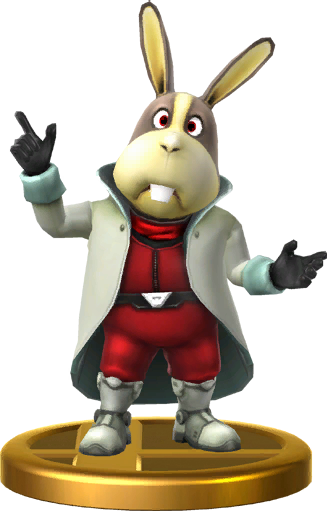

Two members of the Star Fox team, one being a veteran of the original Star Fox led by James McCloud and the other being a childhood friend of Fox. They show up during the Corneria stage in Adventure Mode after you win the first round. They can also be called by Fox or Falco on the Corneria or Venom stages by quickly pressing down on the D-pad. If done correctly, Fox/Falco will kneel, and after a few seconds, the conversation will begin. A similar trick can be done on Brawl's Lylat Cruise stage, although this time the down taunt button needs to be used, and the player needs to wait for the Pleiades to warp before the conversation can begin. Additionally, Slippy appears in Snake's codec if the latter is fighting Falco. In Wii U, they appear on Orbital Gate Assault, this time with no need of doing a taunt but both Fox and Falco have to be absent for the match while every human player has to hold their grab button while loading the stage. In Ultimate, with Corneria, Venom and Lylat Cruise coming back, their respective appearances do too.
- Easter Egg: You are not told how to activate their conversations and they are mainly there just for fans of Star Fox.
- Guide Dang It!: How many people would figure out on their own to quickly tap the taunt button or do under those conditions on those particular stages?
- He Knows About Timed Hits: One of their quotes explains the controls for Melee (and Brawl, 3DS and Ultimate, for that matter).Falco: What? You're just now explaining the controls?!
- I Always Wanted to Say That: Peppy says this word-for-word after saying, "I'm a little shaken, but I'm OK."
- Mythology Gag: Some of their quotes contain these from their home games.
- Playful Hacker: Slippy hacked into Snake's codec channel, apparently just because he wanted to talk to him.
- Secret Character: Not playable, though.
- Wrong Genre Savvy: Sometimes, they'll accidentally tell you the controls for the Star Fox games.

One of Peach's loyal subjects, and one of many Toads whose species shares his name. In the Super Smash Bros. series, he's used in Princess Peach's neutral special, and if anyone hits her, he'll release spores that damage the would-be attacker. Ultimate shows the debut of Blue Toad, who does the same for Daisy, as well as both Toads fighting alongside their Princesses instead of being used as a Human Shield.
- Assist Character: The first character used as a part of another character's attack, rather than being summoned by an Assist Trophy or a PokéBall.
- Counter-Attack: Peach's counter attack. He can be customized in 3DS/Wii U to put them to sleep or be a more standard attack.
- Human Shield: Used as one by Peach in earlier installments. Since Ultimate, they're shown guarding Peach or Daisy on their own volition.
- Palette Swap: Peach uses Red Toad, while Daisy uses Blue Toad (only in gameplay terms, as the two Toads are separate characters in the Mario series).
- Status Effects: One of his customs has him release spores that puts the attacker to sleep instead of harming them.
- Took a Level in Badass: In Ultimate, Toad is not held up unwillingly by Peach, but actually stands to defend her while she ducks behind him. He also factors into her grabs, pummeling opponents while Peach holds them up, and helping her toss them in her throws.
Brawl
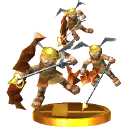
Soldiers enlisted in Palutena's Army. They're willing to fight for Pit and Palutena, even at the cost of their lives (especially since they can just be brought back). They appear in Pit's Final Smash in Brawl, tackling opponents before passing on.
- Death Is Cheap: Palutena can just revive them with no issue, which is why they have no issue throwing themselves headfirst into danger. It's no wonder Pit's the only one who can properly hold his own, since the Centurions have no motivation because of this.
- Demoted to Extra: Thanks to Pit's Final Smash being changed up, the Centurions got demoted to a trophy in 3DS and a spirit in Ultimate.
- Helpful Mook: They live to serve and fight for Palutena.
- Heroic Sacrifice: Their appearance in the Palutena's Army Final Smash has them giving their lives to attack foes. Not that it bothers them anyway.
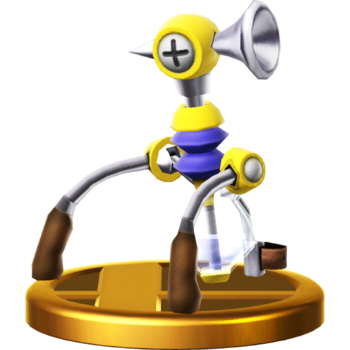
Short for "Flash Liquidizer Ultra Dousing Device", F.L.U.D.D. is a water pack created by Professor Elvin Gadd that assisted Mario when he was framed on Isle Delfino. In Brawl onwards, it becomes Mario's down special, spraying enemies to drive them away.
- Boring, but Practical: F.L.U.D.D. doesn't do any damage (with the exception of a Custom Special), but its push effect can keep opponents at bay. It could have plenty of practical uses this way, one of the most notable purposes being gimping an opponent's recovery by pushing them away from the ledge without restoring their recovery special.
- Making a Splash: Its default attacks deal water-attribute damage.
- Playing with Fire: Scalding F.L.U.D.D. deals fire-attribute damage.
- The Voiceless: While able to speak in its game of origin, F.L.U.D.D. doesn't talk at all in Smash Bros.
Solid Snake's support team. Hal "Otacon" Emmerich is an otaku and close friend of Snake, Mei Ling is a data analyst well-versed in Chinese proverbs, and Roy Campbell is a former member of the U.S. Army and FOXHOUND and father of another of Snake's trusted allies, Meryl Silverburgh. They can be called on the codec on the Shadow Moses Island stage by quickly pressing down on the down taunt button. If done correctly, Snake will kneel, and after a few seconds, the conversation will begin. If Snake is fighting Falco, Slippy Toad will show up on the codec instead.
- A.I. Is a Crapshoot: When calling the Colonel for information on Luigi, it's implied that the Colonel in this case is actually the AI Colonel from Metal Gear Solid 2. This still doesn't explain his hatred of Luigi.
- Breaking the Fourth Wall: As per Metal Gear standards, some of their conversations have no respect for the poor wall.Snake (about Pit): "And by trials you mean, game overs?"
Otacon: "Yeah… You should know all about that." - The Bus Came Back: They return to Ultimate along with Snake and the Shadow Moses stage. It's literally the exact same dialogues used in Brawl (outside of the codec for Link, but it's an omission of a linenote rather than a real dialogue change), even referencing that game by title, with no new ones recorded, but justified due to remaining such out of respect for the death of Takeshi Aono.
- Continuity Nod: In a handful of Codec calls, Snake references the events of The Subspace Emissary. He also has a number of these towards the Metal Gear series itself.
- Cuteness Proximity: Mei Ling adores Pikachu. A pity Snake won't catch one for her.
- Disconnected by Death: This can happen if Snake gets KO'd while they are talking. And yes, the person on the other end screams his name if he dies. Even Slippy.
- Dual Boss: As a spirit, Otacon (possessing a Dr. Mario statue) fights alongside a giant R.O.B.
- Dude, Not Funny!: When the AI Colonel mocks Luigi, Snake coldly condemns his words as a “low blow”.
- Easter Egg: You are not told how to active their conversations and they are mainly there just for fans of Metal Gear, though they do sometimes reveal some extra information about some Nintendo characters, too.
- Exposition Break: Just like in Metal Gear Solid, this is their only purpose (besides saving the game). However, they do it during the action, as opposed to between it.
- Foreshadowing: Some of the things they said made more sense after Metal Gear Solid 4: Guns of the Patriots came out.
- Guide Dangit: Like with Fox and Falco, how many people would figure out on their own to quickly tap the down taunt button on a particular stage? Ultimate does list on how to do this on the Tips page.
- I Always Wanted to Say That: Even Snake and Otacon are unable to resist the joy of a good "Falcoooon PUNCH!" or "FALCON KIIIIIIIICK!"
- Magic Versus Science: Conversed between Snake and Mei Ling if the opponent is Sheik.
- Medium Awareness: As in their own series, they are aware they're in a video game. Otacon makes the most direct references to it.
- Mr. Exposition: They tell all sorts of things about the other characters.
- Mythology Gag:
- Snake and his support team love these in regards to the events of Metal Gear Solid, and once to Metal Gear Solid 2: Sons of Liberty, by way of GW, AKA the Colonel AI.
Mei Ling: [Pikachu will] try to pepper you with electric shocks.
Snake: Couldn't be worse than Ocelot's old torture device…- If Snake is KO'd in mid-conversation, his support staff will begin to panic. Yes, even Slippy.
Campbell: Snake, do you copy? Snake! SNAAAAAAKE!!" - Put on a Bus: As with Snake and other things related to Metal Gear, they do not return in 3DS/Wii U.
- Riddle for the Ages: The Colonel talking about Luigi was an impostor. It’s unknown what the real one thinks of Luigi.
- Secret Character: Not playable, though. Which is just as well, since you are not told how to get them to appear.
- Shout-Out: Their conversations contain several of these, as well as in-jokes.
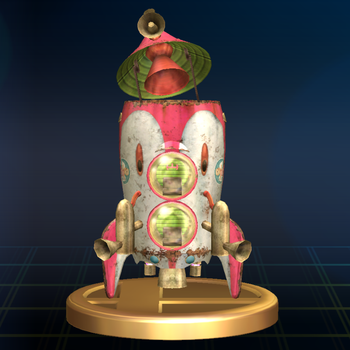
A rust bucket of a ship owned by Hocotate Freight, it becomes Olimar's new ship after his old one gets repossesed to repay the companies massive debt. It appears in Olimar's Final Smash as well as an item, in both occasions having it fly into the air before crash landing on the ground in a fiery explosion.
- The Alleged Car: It sputters and shakes anytime it flies, given its age. It's highlighted in the Subspace Emissary, where it's shown struggling to keep up with other, better maintained spaceships.
- Butt-Monkey: It exists purely to be crashed as part of Olimar's final smash, and is generally not given a particularly flattering portrayal anywhere else.
- Colony Drop: In reference to its home series' love of crashing spaceships, the Hocotate Ship is used this way in Olimar and Alph's Final Smash. Ironically, it is the only ship in the Pikmin series to not have this occur to it at any point.
- Early-Bird Cameo: It's visible at the beginning of "Outside the Ancient Ruins" level, several levels before it's used later by the heroes.
- The Speechless: Notable in this case, as its incarnation in its debut Pikmin game shows it to be notoriously chatty, with a snarky, pompous personality. It never utters a word in any of its appearances in the Smash series.

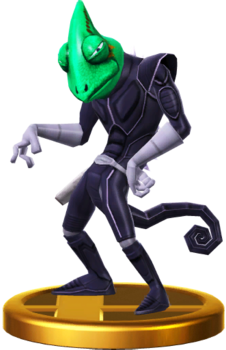
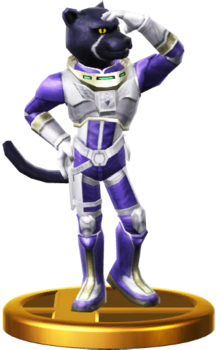
Krystal is an orphaned fox warrior of Sauria turned member of Star Fox, and Fox's love interest, while Leon and Panther are part of the Star Wolf team. They can be called by Fox, Falco, or Wolf on the Lylat Cruise stage by quickly pressing down on the taunt button. If done correctly, the character will kneel, and after a few seconds, the conversation will begin after the Pleiades warps.
- Ascended Extra: Krystal would go on to also become an Assist Trophy in Ultimate.
- The Casanova: Panther is quite the ladies' man and attempts to woo Krystal in at least one conversation. Fitting for someone whose debut was on Valentine's Day.
- Chuck Cunningham Syndrome: They, along with Wolf, are absent from Orbital Gate Assault in Wii U despite being present in the original game the stage takes its inspiration from. Their Easter Egg still shows up on the returning Lylat Cruise stage, however, since Wolf isn't playable, Leon and Panther's dialogue is limited compared to Brawl. Thankfully averted in Ultimate.
- Combat Sadomasochist: Leon. See The Knights Who Say "Squee!" below.
- Deadpan Snarker: Panther certainly has his moments, notably when talking to Leon and Falco.
- Easter Egg: You are not told how to active their conversations and they are mainly there just for fans of Star Fox.
- Friendly Enemies: Slippy tries to strike this dynamic with Leon due to both having long tongues. He is unsuccessful.
- Guide Dang It!: How many people would figure out on their own to quickly tap the down taunt button on a particular stage?
- The Knights Who Say "Squee!": Leon has... quite a bit to say about Wolf.Leon:
 Star Wolf is really giving it his all out there... I'm more than a bit envious of him. Those razor-sharp claws. Those keen fangs. He moves wildly and fights with the spirit of a warrior possessed. Any prey he sets his eye on is doomed to be shredded to pieces.
Star Wolf is really giving it his all out there... I'm more than a bit envious of him. Those razor-sharp claws. Those keen fangs. He moves wildly and fights with the spirit of a warrior possessed. Any prey he sets his eye on is doomed to be shredded to pieces.
Panther: Umm...Leon? Are you feeling all right?
Leon: Yes, of course! Fine! Just fine. Haa ha haaaa ha haaahaaa...
Panther: Set me straight here, Leon. Are you envious of the shred-DER or the shred-DEE? - Not So Above It All: In one of the dialogues, Krystal seems like she is admonishing Peppy and Slippy for thinking they could be part of the Brawl, only to then say she is the better choice.
- Pre-Asskicking One-Liner: Panther gets a pretty good one.Do you see my red rose? It marks your imminent death!
- Red Oni, Blue Oni: Leon and Panther seem to share this mechanic when Wolf is on the stage.
- Secret Character: Not playable, though. Which is just as well, since you are not told how to get them to appear.
- Sickening Sweethearts: At the end of an entire conversation between Krystal and Panther which purely amounted to flirting with each other, Falco gets sick of it.

A talking snake obtained by Lucas's friend Duster after trading with the ghosts of Osohe Castle. In its home game, it could be used like a grappling hook. Lucas borrows it to fight, using it as his grab.
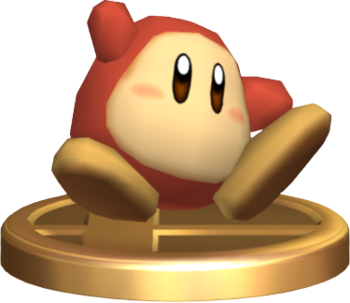


Waddle Dees are the most basic enemy in the Kirby series, Waddle Doos are a stronger variety with the ability to attack from afar with a beam whip, and Gordos are spiked balls who are usually impervious to attacks. In Brawl, these three were summoned when King Dedede used his Side Special, and could also be summoned by his Final Smash. 3DS/Wii U onwards makes it so only Gordos can be thrown, though all three appear as enemies in Smash Run.
- The Artifact: Despite no longer being involved in Dedede's moveset, a Waddle Dee still appears in one of his victory animations.
- Assist Character: For King Dedede in Brawl, being summoned onto the field using his Waddle Dee Toss attack, with Waddle Dees being the weakest and most common and Gordos being the opposite end. In 3DS/Wii U, only Gordos fulfill this role for King Dedede.
- Demoted to Extra: 3DS/Wii U removes Waddle Dees and Waddle Doos from Dedede's arsenal, though they do still appear as Smash Run enemies, Waddle Dees still appear in King Dedede's Battle Intro and one of them is still in one of King Dedede's victory poses. Waddle Doos are not so lucky in Ultimate, being now reduced to just a spirit while Waddle Dees keep the same roles as before, baring being an attackable enemy.
- Invincible Minor Minion: The Gordos that appear in Smash Run hover around and can't be defeated. On the upside, they can damage other enemies that touch them.
- Mooks: All of them become this in Smash Run in 3DS, behaving like how they do in their original series. Parasol Waddle Dees, which are Waddle Dees with a Parasol, also appear in this capacity.
- Shock and Awe: Waddle Doos can whip players with electricity.
3DS/Wii U

One of the main characters in Fire Emblem: Awakening, Chrom is the leader of the Shepherds, prince of Ylisse, Lucina's father and a good friend of Robin. He appears as part of Robin's Final Smash and takes part in the Palutena's Guidance for Robin in Wii U.
Chrom gets Promoted to Playable in Ultimate, as an Echo Fighter of Roy with some elements from Ike, although he still retains his role in Robin's Final Smash. For more information on his role as a player character, see here.
- Almost Dead Guy: In Lucina's and Robin's trailer, as he lies defeated, he bemoans he never got a chance to prove his mettle in combat and will have to wait for the next time. Then the caption at the bottom of the screen corrects him.
- Assist Character: He's summoned to assist Robin with their Final Smash. He still fills this role in Ultimate, despite now being a separate playable character.
- Badass Cape: He wears a tattered white cape over his left arm. It sure looks badass in battle.
- Badass Normal: Like many a Fire Emblem lord, he's just a capable swordsman.
- Bash Brothers: With Robin, reflecting the importance of their relationship in Awakening. Chrom and a male Robin are Heterosexual Life-Partners, whereas he and a female Robin are either Platonic Life-Partners or an outright Battle Couple depending on player preferences.
- Birthmark of Destiny: The Brand on the Exalt/Mark of Naga on his bare right shoulder, symbolizing his Heroic Lineage and the blood pact his family line made with Naga in ancient times.
- Butt-Monkey: Gets ribbed quite a bit during Palutena's Guidance on Robin in Wii U.
- The Cameo: He shows during Palutena's Guidance for Robin in Wii U, becoming the target of some divine teasing by Palutena and Viridi.
- Cool Sword: The Falchion, forged from a fang of the Divine Dragon King Naga and handed down among the bloodline of the Hero King Marth. Chrom puts it to good use while Pairing Up with Robin.
- Promoted to Playable: He becomes an playable in Ultimate, but he still assists Robin in their Final Smash.
- The Resenter: In Palutena's Guidance on Robin in Wii U, he seems just a little bitter about not taking part in this fight. He promises that him and Robin will make his opponents taste the bitterness of defeat.
- Royals Who Actually Do Something: The first prince of the Halidom of Ylisse and The Captain of the Shepherds, a peacekeeping militia that protects the Ylissean people and borders. In Smash, he stands by his army's tactician, Robin, when they require his assistance.
- Super Move Portrait Attack: Robin's Final Smash uses the portrait cut-in associated with Criticals and Skills in Awakening. As Chrom is the one directing his Combination Attack with Robin, his artwork is shown.
- Sword and Sorcerer: He's the Sword to Robin's Sorcerer in their Final Smash.
- Throw the Dog a Bone: After getting the short end of the stick through Lucina's and Robin's debut trailer, the end shows that he wasn't completely shafted from a chance on the Smash battlefield. Ultimate eventually puts him on the roster.
- The Worf Effect: He may be a powerful swordsman, but he still gets his butt kicked by Captain Falcon in his daughter's and comrade's trailer.
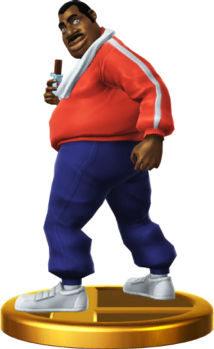
A former W.V.B.A. (World Video Boxing Association) heavyweight champion who took Little Mac under his wing. He's quite fond of chocolate. In Smash, Doc appears on Mac's victory screen to congratulate him. He also will shout words of encouragement sometimes when Mac taunts.
- The Cameo: He will occasionally give Mac advice through his taunts. He will also appear in Mac's victory poses to congratulate him.
- Easter Egg: He will occasionally chime in when Little Mac taunts. It's random, and the game itself won't tell you.
- Trademark Favorite Food: Like his home series, he loves all things chocolate.
- Voice for the Voiceless: He serves as one for Little Mac.
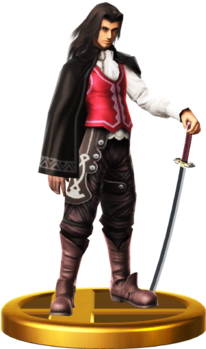
One of Shulk's friends, Fiora's older brother and a renowned hero in the Battle of Sword Valley. Even though he's lost the use of his right arm, he's still a capable fighter. A party member of Xenoblade Chronicles and former wielder of the Monado, Dunban appears to assist Shulk in his Final Smash, alongside Riki.
- Assist Character: To Shulk in his Final Smash.
- Badass Cape: He wears a black cape over his barely working right arm, looking cool while not getting in the way during battle.
- Handicapped Badass: He lost the use of his right arm thanks to the Monado, but he kicks not a single ass less with only his left arm.
- Human Aliens: Same as Shulk, he's not a human, but a Homs.
- Katanas Are Just Better: His weapon of choice is a katana made of Mechon metal, which in Xenoblade Chronicles makes it capable of damaging the robots without the aid of the Monado.
- Master Swordsman: Wielded the Monado during the Battle of Sword Valley long enough to drive off the Mechon invasion, before losing the use of his right arm completely. Even then, he's able to easily wield a katana with his left.
- Situational Hand Switch: He is not actually left-handed, but he is forced to use his left arm to fight since his right arm has all but stopped working thanks to an Heroic RRoD caused by the Monado.

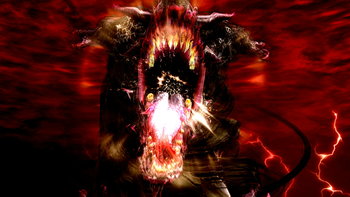
Usually, a step to become an Umbran Witch is to make a deal with a demon from Inferno in exchange for great magical power and to be able to summon other Infernal Demons. In Bayonetta, Madama Butterfly, Mistress of Atrocity, serves as Bayonetta's demonic sponsor, her limbs being used to create Wicked Weaves and her wings used for Bayonetta's double jump. Gomorrah, Devourer of the Divine, is one of Bayonetta's go-to demons when killing larger angels. In Smash, Madama Butterfly serves for Bayonetta's Smash attacks, her double jump, and her silhouette is visible as Bayonetta's shadow (except in 3DS due to hardware limitations). For her Final Smash, Bayonetta summons Gomorrah to chomp up her enemies, instantly KO'ing them if they're above 100%.
- Combat Stilettos: Shown in Bayonetta's Down Smash.
- The Ghost: The most we see of Madama Butterfly in this game is her hands and feet, though her full body can be seen in Bayonetta's shadow.
- Giant Foot of Stomping: Bayonetta's Down Smash summons Madama Butterfly's foot to crush her enemies. It's especially savage to opponents clinging to ledges, where they're instantly meteor smashed if hit from above.
- Good Wings, Evil Wings: The butterfly wings Bayonetta sports in double jumping are actually Madama Butterfly's wings. Given that Bayonetta serves as a Heroic Comedic Sociopath and their terms are good, it's questionable whether Madama Butterfly is completely evil or not.
- Names to Run Away from Really Fast: They don't bear the titles of "Mistress of Atrocity" and "Devourer of the Divine" for nothing.
- The Shadow Knows: In Wii U and Ultimate, Bayonetta's shadow is actually that of Madama Butterfly, the Infernal Demon from whom she derives her basic powers.
- Summon Bigger Fish: The entire point of Gommorah's appearance.
- Summon Magic: Bayonetta's Wicked Weaves allow her to summon the fists and feet of Madama Butterfly. Her Final Smash summons the draconic demon Gomorrah to nom up her opponents.
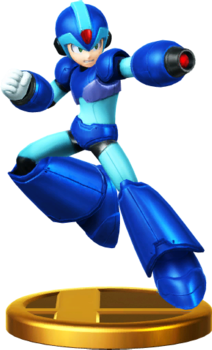
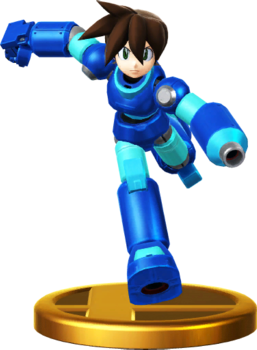
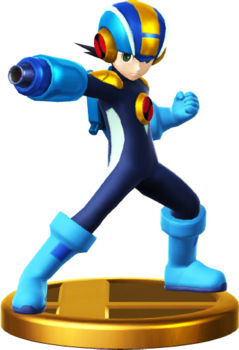
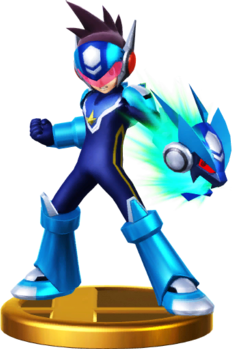
Four successors/alternate versions to Mega Man, each Mega Man being a main character and protagonist of their own series. X is a fully sentient robot that served as the basis of the Reploids, Maverick Hunter, the classic Mega Man's successor, and Dr. Light's last and greatest creation. Mega Man Volnutt is a Digger searching for energy sources alongside his adoptive family. MegaMan.EXE is a NetNavi used by Lan Hikari to take out the various viruses of their universe. Geo Stelar is a young boy fighting alongside the alien Omega-Xis to deal with the EM Viruses plaguing their world. The original Mega Man summons them all to assist him in nuking the enemy with laser beams from their Mega Busters if Mega Man's Final Smash connects with an opponent.
- All Your Colors Combined: Each Mega Man fires a different-colored beam from their Mega Busters.
- Alpha Strike: What Mega Man summons them for.
- Anime Hair: Mega Man Volnutt has rather big spikes hanging over his forehead. Geo Stellar also has large upright spikes at the back of his head.
- Assist Character: Summoned by Mega Man to assist him in nuking his target(s) with their Mega Buster beams should his Black Hole Bomb connect with an opponent.
- Energy Weapon: All four of them along with Mega Man himself shoot powerful laser beams at the victim(s).
- Helmets Are Hardly Heroic: Mega Man Volnutt is the only one in the group to not be wearing a helmet of any kind.
- Heroic Mime: They remain silent, just like the original Mega Man.
- Irony: In the Mega Man X series, robots that desire to harm humans are called "Mavericks". X fears that he could go maverick at some point. But for this appearance, he seems to have forgone that fear, as he has no qualms blasting any human that gets trapped.
- Shown Their Work: For such a short cameo, the developers took extra care detailing them. EXE, for example, fires his Buster with his right arm just like his original appearance. The others use their left.
- Token Human: Mega Man, X, Mega Man Volnutt, and MegaMan.EXE are all entirely technology, either being full androids or a software program. Geo is an ordinary human boy teaming up with an alien.
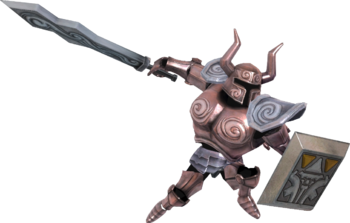
Walking suits of armor that patrol the Temple of the Ocean King and the Tower of Spirits who were originally created by the terror known as Bellum. After his defeat, they became less prompted to hurt innocent people, though the evil released from the broken Spirit Tracks corrupted them and caused them to see anyone as an intruder. They could, however, be possessed by Zelda's spirit to assist Link in the tower. Now that Bellum and Malladus are taken care of, they serve as Zelda's down special.
- Animated Armor: They're walking, inanimate suits of armor.
- Assist Character: Phantoms are summoned by Zelda as both a method of attack and defense.
- Composite Character: Of note is that neither version of Zelda that can use the Phantom Slash move (Twilight Princess Zelda in 3DS/Wii U and Link Between Worlds Zelda in Ultimate) were actually associated with Phantoms in their own games.
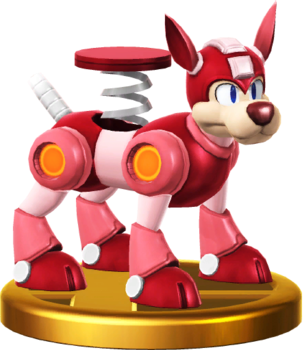

Rush is Mega Man's robotic canine companion and a huge asset across his adventures. In Smash Bros, Mega Man can use the Rush Coil as a recovery move, enabling him to jump on Rush's back like a spring. He also has a custom special that replaces him with Beat, a robot bird created by Dr. Cossack after Mega Man saved his daughter, Kalinka.
- Adaptational Wimp: In Mega Man's games, Beat is perfectly capable of fighting by itself, pecking at anything that comes near it. Here, he doesn't even do a small amount of damage.
- Assist Character: Rush only appears in Mega Man's up special, while Beat is a custom special.
- Canine Companion: Rush is one that can function as a spring, a jet, a submarine, a spaceship and even Power Armor. In this title, he only really uses the spring.
- Demoted to Extra: Due to the removal of custom specials in Ultimate, Beat's only appearance in that game is as a Spirit.
- Robot Dog: Rush, obviously. Beat is a robot bird.
- Team Pet: Both characters count as such, being a dog and a bird respectively.


The local storekeeper in Villager's town, Tom Nook sells a home to the Villager, which can be expanded on. He also has two sons, Timmy and Tommy Nook, who help him with the family business. In Smash, Tom and the Nooklings team up with the Villager and Isabelle's Final Smashes.
- Assist Character: Summoned by the Villager or Isabelle during their Final Smashes. They build a house or a town hall which then promptly explodes.
- Graceful Loser: While he's visibly morose about failing to be Promoted to Playable like Isabelle after her reveal trailer, he still states that he's happy for Villager and Isabelle getting to join the fight and resolves to get decent homes ready for them in the untitled-at-the-time Animal Crossing: New Horizons.

A group of outlaws from the titular game. They serve as Duck Hunt's down special, shooting at opponents and serving as somewhat of a shield. They also appear in Duck Hunt's Final Smash, having a shootout with the Hogan's Alley targets.
- Assist Character: They can be summoned by the Duck Hunt Dog to shoot at enemies, and even serve as somewhat of a shield.
- Goofy Print Underwear: The skinny man can have his pants drop when attacked, revealing his polka dotted boxer shorts.
- Human Shield: You can summon them to take hits for you.
Ultimate

Not pictured: Byte & Barq, Kid Cobra
Brawlers from all over the world, fighting amongst one another to prove themselves to be the champion and united by their unique ability to extend their arms across vast distances with their spring-like ARMS. They appear as part of Min Min's Final Smash attack, lending their ARMS to lay the smackdown on her opponents. Fighters that appear include:
- Spring Man: A spirited boxer. Attacks with a Toaster ARM. Also appears as an Assist Trophy and Mii Brawler costume.
- Ribbon Girl: An Idol Singer. Attacks with a Sparky ARM. Also appears as a Mii Brawler costume.
- Ninjara: A Ninja-in-training. Attacks with a Chakram ARM. Also appears as a DLC Mii Brawler Costume.
- Master Mummy: A massive and aggressive mummy. Attacks with a Megaton ARM.
- Mechanica: A Child Prodigy who pilots a Mini-Mecha. Attacks with a Revolver ARM.
- Twintelle: A glamorous movie star. Attacks with a Chilla ARM.
- Badass Normal: Mechanica doesn't have the ARMS gene, but she can still roll with the rest of the roster thanks to her Mini-Mecha.
- Mask of Power: With the exception of Master Mummy (who is covered from head to toe in bandages) and Mechanica (who is a Badass Normal), everyone with the ARMS gene wears a special mask that helps them to keep their otherwise-unwieldy spring-like arms under control.
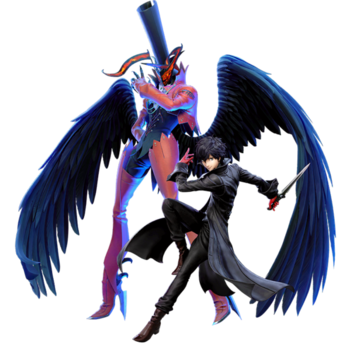
Personas are metaphysical manifestations of one's personality, created to help one deal with hardships in life. In the Persona series, they take the form of a Fighting Spirit, with the Personas of Persona 5 being born from their users' rebellious spirits. While Joker has the power of the Wild Card, which allows him to summon multiple Personas, his first and most famous Persona is Arsène, manifested from his indignation at the injustice he suffered from those who abused their power. In Ultimate, Arsène can be summoned when his Rebellion Gauge is filled, strengthening Joker's attacks temporarily.
- Adaptational Badass: As a starter Persona, Arsène has middling-at-best stats and is very likely to be replaced with stronger Personas as the player progressed, unless the player is extremely dedicated to using certain fusion methods to strengthen him. In Ultimate, however, he is the only Persona Joker uses, and has access to powerful skills that he doesn't have by default, including Eigaon (a high tier Curse spell), Tetrakarn (a shield that deflects physical damage), and Makarakarn (a shield that deflects magic damage).
- Casting a Shadow: Arsène is primarily associated with the "Curse" element in his home game. In Ultimate, he gives Joker the ability to cast Eiha and Eigaon, dark-based magic attacks.
- Combat Stilettos: He has bladed high heels, which he'll use to kick foes into submission once he's summoned.
- Dark Is Not Evil: Arsène's design invokes a demon-like appearance, with large horns and a scary red face, and uses Curse element attacks. However, as an extension of Joker's mind and will, he's heroic.
- Named After Someone Famous: Arsène's namesake is Arsène Lupin, the Gentleman Thief of French literature fame. Viewers of famous anime might recognize his grandson, Lupin III.
- Red Baron: He refers to himself as "the Pillager of Twilight" in his home game.
- Super Mode: In practice, Arsène functions as a super mode for Joker in Ultimate, temporarily increasing his attack power when he is active.
- Tarot Motifs: Different Personas are classified under different Arcanas of the tarot deck. Arsène in particular is a part of The Fool class of Personas.
- The Voiceless: Arsène has some voiced lines in the original game, as well as in the teaser trailer for Joker's inclusion. In-game, however, he remains silent.
- Winged Humanoid: Arsène has a pair of large black raven-like wings, which he lends to Joker when summoned as part of his Wings of Rebellion recovery special.
A denizen of the Cap Kingdom who aided Mario during the events of Super Mario Odyssey in order to save his sister, Tiara, when Bowser uses her as a wedding accessory. In Ultimate, he resides on Mario's head, and will poke his eyes out when Mario uses his Super Jump Punch and when Mario throws his hat during a taunt.
- Animate Inanimate Object: He's a living hat.
- The Cameo: He doesn't play an active role in the game, instead making fried appearances during some of Mario's moves.

Creepers are monsters commonly found in the Overworld of Minecraft, as well as the most recognizeable monster in the game. Distinguished by their ghastly green skin, strangely upright bodies, and hideous faces, Creepers are a bane to any who build, as they have a nasty habit of sneaking up on unsuspecting victims before self-destructing, their explosions causing serious damage and bodily harm to those nearby. In Ultimate, they appear as part of the Final Smash for Steve, et al., self-destructing on the hapless victim that was shoved into a TNT-filled building.
- Action Bomb: When they draw close to their victim, they self-destruct after a moment's delay, causing a powerful explosion.
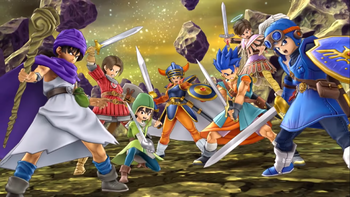
The other Heroes that have appeared through the mainline Dragon Quest games. While not playable themselves, they help the four playable Heroes channel their power for their Final Smash. They include:
- The Descendant of Erdrick: The Hero of Dragon Quest, who saved the realm of Alefgard from the dark clutches of the Dragonlord.
- The Prince of Midenhall: The Hero of Dragon Quest II, who joined forces with his cousins from Cannok and Moonbrooke to defeat the dark lord Hargon.
- The Son of Pankraz: The Hero of Dragon Quest V, who squared off against the dark priest Ladja to save his family.
- The Prince of Somnia: The Hero of Dragon Quest VI, who took it upon himself to defeat the evil wizard Murdaw.
- The Fisherman's Son: The Hero of Dragon Quest VII, who embarked on a grand journey to save his world from oblivion.
- The Sentinel of the Starry Skies: The Hero of Dragon Quest IX, who descended from the heavens to save the world from a potentially destructive power.
- The Boy from Tenton: The hero of Dragon Quest X, who reincarnated after his death to save the world from the threat of monsters.
- Combination Attack: Much like with Mega Man, they combine their powers together for the Hero's Final Smash.
- Heroes Prefer Swords: As the heroes of their respective games, all of them are shown wielding swords... except for Madason (the hero of V) since he's actually the father of the real hero in his home game.
- Winged Humanoid: The hero from IX, being a Celestrian, has angel wings.

A Childhood Friend of Shulk's, sister to Dunban, and party member of Xenoblade Chronicles, Fiora ended up getting fatally struck by Metal Face with seemingly no hope for survival. However, thanks to a Grand Theft Me from the goddess Meyneth, she survived with a new Mechon-enhanced appearance to boot. Fiora appears to help Shulk, Dunban and Riki during the former's Final Smash in Ultimate.
- Action Girlfriend: She has a Childhood Friend Romance with Shulk and is more than capable of kicking some serious tail.
- Ascended Extra: Went from being two trophies (one for her human and Mechon forms, each) in 3DS/Wii U to a part of the Chain Attack in Ultimate.
- Assist Character: Ultimate adds her to Shulk's Final Smash, even though Shulk can only have two other party members.
- Cyborg: A Homs outfitted with Mechon technology.
- Dual Wielding: She attacks with the two swords that came with her Mechon abilities.
- Human Aliens: Just like Shulk and Dunban, Fiora is a Homs.
- Late-Arrival Spoiler: The fact that she was turned into a Mechon was a major plot point in Xenoblade Chronicles.
- Power Floats: She can fly, and appears while floating, though her home series implies that this is part of Meyneth's abilities and not her own.
- Robot Girl: She appears in her Mechon form, a massive spoiler for those who are unfamiliar with Xenoblade Chronicles's story.
- The Voiceless: Fiora wasn't given any recycled dialogue to use during her appearance. Similarly, while Shulk does call her name, he has no other voice clips regarding her, and neither do Dunban and Riki.
- We Can Rebuild Him: Fiora was murdered by Metal Face and was given a Mechon body so she could survive as a Mechon pilot and act as a vessel for the goddess Meyneth. This later happens again in a much more benevolent sense as she gets her organic body back.

Jinjos are colorful, long-snouted creatures who frequently find themselves in trouble in the various regions of the Isle O'Hags. Banjo and Kazooie first encountered them as captives in Gruntilda's Lair and the magic worlds contained within. In many of the duo's adventures, finding all the Jinjos in a given world (or of a certain color in Tooie) would give them a Jiggy. In their original appearance, they repaid the duo by summoning the Mighty Jinjonator, a statue animated by Kazooie's eggs that deals the final blow against Gruntilda. In Ultimate, it appears as Banjo and Kazooie's Final Smash.
- The Bus Came Back: This is only the second time the Mighty Jinjonator has ever appeared since its debut in 1998.
- Mistaken for Granite: Banjo & Kazooie initially summon the Jinjonator from the ground as a statue, but it quickly breaks out of its stone shell to attack their opponents.
- Mythology Gag: The Banjo & Kazooie reveal trailer has them summon the Jinjonator to attack King K. Rool, who then falls and makes a hole in the ground that a boulder traps him in much like what happened to Gruntilda. The Jinjonator's role in the battle against Gruntilda is also referenced in the Gruntilda Spirit battle, where the Smash Ball will appear once Gruntilda Dedede's health is low enough.
- Red Eyes, Take Warning: Its red eyes emphasize its powerful nature. They've been given some Art Evolution by making them segmented and almost insect-like.


Like Ness, Lucas has two of his companions help him in his Final Smash. Kumatora is a tomboyish princess gifted with PSI, while Boney is Lucas's faithful dog.
- Ascended Extra: They both appeared as stickers in Brawl, and Kumatora was mentioned in Lucas's PK Starstorm trophy in Brawl and Wii U.
- Assist Character: Like with Ness, Kumatora was said to have taught Lucas how to use PK Starstorm in Brawl and Wii U, but in Ultimate, she instead performs the move herself.
- Badass Adorable: Kumatora is pretty adorable for a confirmed 17-year-old, and she's adept at all kinds of offensive PSI attacks. The same goes for Boney, being a friendly dog who proves to be a powerful asset to Lucas.
- Badass Normal: Boney is one of two main party members to be this in MOTHER 3, the other being Duster (or one of four, if Flint and Salsa are included). His main use was utilizing his insane speed to get the first hit.
- Canine Companion: Boney. He was originally the companion of Lucas's father, Flint, before joining up with Lucas.
- Tomboy Princess: Kumatora is considered the princess of Osohe Castle due to the Magypsies taking care of her, but she doesn't act or dress the part.

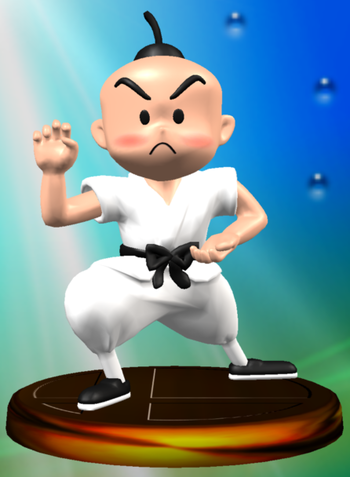
Two of Ness's traveling companions. Paula Polestar is an average girl from the town of Twoson who is gifted with the power of PSI. Poo is the crown prince of the exotic country of Dalaam. Both aide Ness in his Final Smash in Ulimate.
- Ascended Extra: After only making minor appearances in each game, in Ultimate, they finally show up in person to give Ness a hand.
- Assist Character: Brawl and Wii U both said that Ness was taught how to use PK Starstorm (which he never learns in EarthBound) by Poo, but in Ultimate Ness instead calls upon Poo and Paula to perform the move themselves.
- Badass Adorable: Just look at them! You wouldn't guess they're powerful users of PSI on looks alone, would you?
- Beware the Nice Ones: Paula may be a kind, cute teacher's daughter, but her PSI powers could wreck any foe's day.
- Early-Bird Cameo: They appeared in Melee as trophies.
- Royals Who Actually Do Something: Poo is the prince of Dalaam and has trained his body and mind to assist Ness. He's even mastered PK Starstorm, originally being the one to teach it to Ness before joining him to use the move.
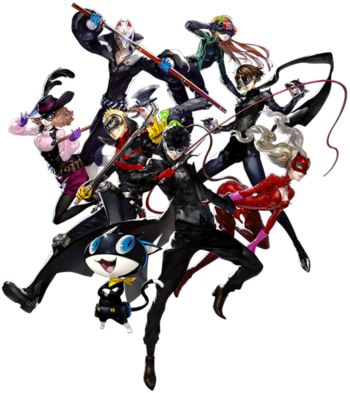
Panther: What's so important that he'd run off by himself?
Mona: There's only one thing the Phantom Thieves of Hearts specialize in!
Fox: He's there to steal a Treasure! Have you already sent a calling card?
Mona: We're not the ones sending a card this time. In fact, we've been invited!
Led by Joker, the Phantom Thieves of Hearts are a group of teenagers (and a magic talking catnote ) united by abuses they suffered at the hands of corrupt adults and a shared desire to reform society. To that end, they delve into the Metaverse to steal the treasures of those who abuse their power and force them to repent for their misdeeds. Six of the Thieves (Morgana, Ryuji, Ann, Yusuke, Makoto and Haru) can appear to assist Joker in his Final Smash with Futaba commenting on it, and with the exceptions of Futaba and Akechi, they randomly appear in the background of the Mementos stage. Morgana also appears in Joker's taunts and victory screen. Among the Thieves' ranks are:
- Morgana (Mona): A strange cat-like being who helps organize the Thieves in the first place in the hopes of regaining his human form. Wields a cutlass and possesses the Persona of "Zorro".
- Ryuji Sakamoto (Skull): A Japanese Delinquent and former track star whose aspirations were demolished by an abusive coach. Wields a pipe and possesses the Persona "Captain Kidd".
- Ann Takamaki (Panther): A mixed-race part-time model who found herself the target of a perverted coach. Wields a whip and possesses the Persona "Carmen".
- Yusuke Kitagawa (Fox): A gifted artist whose talents were exploited by an unscrupulous mentor. Wields a katana and possesses the Persona "Goemon".
- Makoto Niijima (Queen): The student council president and sister of a public prosecutor, who desperately seeks her own path in life. Wields brass knuckles and possesses the Persona "Johanna".
- Haru Okumura (Noir): The daughter of a corporate president who is trying to marry her off as a means to attain political clout. Wields an axe and possesses the Persona "Milady".
- Futaba Sakura (Oracle / Navi): A young shut-in and Otaku who fell victim to a conspiracy responsible for her mother's murder. Doesn't fight, but provides logistical support and buffs with her Persona "Necronomicon".
- Goro Akechi (Crow): A prodigal private detective and the Phantom Thieves' main rival. Wields laser blades and possesses the Persona "Robin Hood".note
- Assist Character: Except for Akechi, the Thieves take turns joining Joker's All-Out Attack, and cheer on fighters in Mementos.
- Badass Boast: They're pretty proud of Joker's victories, and chime in with a quote of their own during the results screen:Ryuji: Hah! Losers!
Ann: Aren't we the best?
Yusuke: And the curtain... falls.
Makoto: Don't forget this feeling!
Futaba: Hehehe... they're done for!
Haru: So much for them! - Big "WHAT?!": Ann has one when Joker reveals his invitation for Smash. It was even Erika Harlacher's (Ann's English voice actress) genuine reaction.
- Calling Card: Mentioned in the VGA teaser trailer: the Phantom Thieves send out calling cards to their intended victims before stealing their treasure.
- Celebrity Paradox: A few references in their home games have been made to other franchises that actually exist in this game. Morgana has dressed up as Sonic, Joker can reference Metal Gear and Pokemon and plays a parody of Punch-Out!!, and Futaba especially has Pac-Man stickers, a Splatoon-esque T-Shirt, references Sonic, Pokemon, and Smash itself (and in Royal, would continue with references to Final Fantasy VII: Advent Children, Dragon Quest IV, and Star Fox). For an example in-game, Futaba's Japanese code name, Navi, is a reference to the Zelda character of the same name who appears in Young Link's taunt.
- Code Name: Each member of the Thieves has their own code name, which they chose for themselves, that they use when they're out and about in the Metaverse, in order to conceal their identities. They are as follows:
- Morgana: Mona
- Ryuji: Skull
- Ann: Panther
- Yusuke: Fox
- Makoto: Queen
- Futaba: Oracle (Navi in Japanese)
- Haru: Noir
- Akechi: Crow
- Combat Commentator: With the exception of Akechi, each of them chimes in with applause when a KO occurs when fighting in Mementos, and when Joker wins, one of them will randomly throw in a victory quote just like their home series.
- Demoted to Extra:
- Goro Akechi is the only Phantom Thief to not have any sort of presence outside of his Spirit battle, as well as being the only member of the group to not be included on the Phantom Thieves of Hearts spirit, likely owing to his Guest-Star Party Member and Sixth Ranger Traitor status in the original game.Note His only appearances in-game is as a Spirit and his Phantom Thief outfit being an alternate color for Joker.
- There is also Kasumi/Sumire Yoshizawa, Sophia and Zenkichi Hasegawa, who don't appear at all, but this is justified in that the former only appears in Persona 5 Royal and the latter two in Persona 5 Strikers, neither of which had been released in Japan at the time Challenger Pack 1 came out.
- Kid Hero: Each of them hover around being 16-18 years old (with the exception of Futaba, who is 15 years old), and they serve as the main protagonist team of Persona 5.
- Leitmotif: "Last Surprise"
 plays for almost all their Spirit battles, with the exception of Futaba, who has the new remix of "Beneath The Mask"
plays for almost all their Spirit battles, with the exception of Futaba, who has the new remix of "Beneath The Mask" , and Akechi, who has "Rivers in the Desert"
, and Akechi, who has "Rivers in the Desert" . When fought collectively, the Phantom Thieves swap those out in exchange for the intro song of their home game, "Wake Up, Get Up, Get Out There"
. When fought collectively, the Phantom Thieves swap those out in exchange for the intro song of their home game, "Wake Up, Get Up, Get Out There" .
. - The Knights Who Say "Squee!": In the trailer, Futaba is especially excited at seeing all the fighters Joker faces. Knowing her, she’s probably played all their games. In fact, she mentions the Smash Bros. series by name in her home game.
- Mask of Power: The source of each Phantom Thief's Persona power is in their masks. Ryuji's mask resembles a skull, Ann wears a red panther mask, Yusuke sports a fox mask, Makoto wears an intimidating metal halfmask, Futaba's mask is a pair of bulky red goggles, Haru wears a black domino mask and Akechi wears a red bird mask with a long beak. Downplayed with Morgana, who appears to wear a black cat-eared bandana mask, but who doesn't take off his mask when summoning his Persona.
- Mythology Gag: Many of the Thieves' win quotes for Joker are taken word-for-word from the post-battle results screen in Persona 5.
- Phantom Thief: The group are collectively known as the Phantom Thieves of Hearts, where their appearances embody this trope. They also pull off heists, though the one that gets Joker into Smash Bros. is the one that is explicitly shown in Smash.
- Pre-Asskicking One-Liner: Morgana or Futaba will drop one when Joker successfully pulls off his Final Smash; again, most of them are taken word-for-word from their home game:Morgana: Time for some brutality! / Quiver in fear! / It's too late for apologies!
Futaba: Beat 'em up! / Here comes the pain! / Time for an All-Out Attack! - A Shared Suffering: All of the Phantom Thieves (save for Morgana) have dealt with abuses from those who misuse their power and influence: Joker was wrongfully charged with assault from a drunkard who was assaulting a woman, Ryuji was physically abused by a teacher who was also sexually harassing Ann, Yusuke's mentor worked him like a slave to make money and increase his prestige with plagiarized art, Makoto was manipulated by school administrators and nearly extorted by a greedy yakuza, Futaba was gaslit into believing she was responsible for her mother's death, Haru was nearly married off to an abuser just to further her father's political ambitions and Akechi's father abandoned him while his mother committed suicide, leading to him being passed around several abusive foster homes.
- Super Move Portrait Attack: Like in their home game, the participants of the All-Out Attack get their own special character portraits that appear before they lay the smackdown.
- This Cannot Be!: Ryuji's reaction to Joker getting into Ultimate in the announcement trailer, with his particular delivery.Ryuji: Smash Bros.?! Is this for real?!
- True Companions: They stand by each other through thick and thin against all odds. This is best represented in-game by their Spirits' aversion of the Fallacy of Division. Each of the Thieves have varying levels of strengths when their Spirits are faced individually (Morgana is an Ace, Ryuji, Ann and Akechi are Advanced, all others are Novices), but the collective Phantom Thieves of Hearts Spirit is a Legend-class. While Akechi doesn't appear in the artwork for the team Spirit, his own Spirit's Item Gravitation effect has great synergy with the Phantom Thieves' Item Autograb effect, proving that they are at their absolute best when fighting alongside each other.
- The Voice: Futaba doesn't appear in any physical capacity, but she'll occasionally throw in a Bond One-Liner when Joker performs an All-Out Attack and a win quote for the results screen.
- Voluntary Shapeshifting: Morgana has the ability to transform himself into a van that the Thieves drive around in while in Mementos and other Metaverse areas. As for why he can do this, he explains in his home game that "cats turning into buses is a widespread cognition amongst the general public".
- Wake Up, Go to School & Save the World: With the exception of Futaba, all of the human Thieves are high school students who resume daily life as normal whenever they're not fighting in the Metaverse. Almost all of them hail from Shujin Academy - Joker, Ann and Ryuji are second-year students while Makoto and Haru are their seniors. Yusuke is also a second-year but studies at Kosei High instead, whereas Akechi is a third-year who attends a school that is never named.
- Wolverine Publicity: Despite not being playable, Morgana shows up quite often in gameplay and promotional material. He appears in Joker's taunts and victory animations, as well as beside him on Ultimate's panoramic artwork - he is only one of three non-fighters present on it, an honor he shares with Mr. Saturn and Slime.
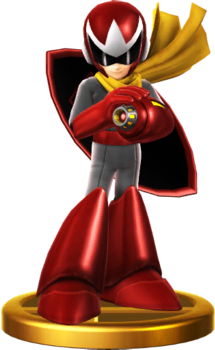

Proto Man is the first robot created by Dr. Light and thus, is considered to be Mega Man's older brother. Bass is a robot created by Dr. Wily made to rival Mega Man, but has gone against his creator several times and even helped Mega Man on occasion. Both appear in Mega Man's Final Smash in Ultimate, joining the ranks of the other Mega Men.
- Aloof Ally: Proto Man values his independence and never sticks around for long, but is a firm friend of Mega Man nonetheless.
- Ascended Extra: Both characters went from being trophies in 3DS/Wii U to being a part of Mega Legends in Ultimate.
- Assist Character: Ultimate adds them to Mega Man's Final Smash.
- Canine Companion: Bass has one in Treble, an Evil Counterpart to Rush. He shows up in Bass's Wii U trophy, but doesn't appear in Mega Legends.
- Early-Bird Cameo: Both appeared in Wii U / 3DS as trophies.
- Enemy Mine: While this isn't the first time he's teamed up with Mega Man, Bass forgoes his usual efforts and helps Mega Man during the latter's Final Smash.
- Shadow Archetype: Bass is like a dark version of Mega Man. While not outright evil, he is self-centered and obsessed with proving himself to be the superior robot, a goal which sometimes pits him against his creator Dr. Wily.

The main protagonist of Xenoblade Chronicles 2. Rex works as a salvager, a person who dives into the Cloud Sea to salvage whatever they can find beneath its surface. His expertise lands him a job of salvaging a sunken ship, where he finds Pyra in a comatose state. After awakening her, he becomes her Driver, and the two set off on a journey to get Pyra back to Elysium.
In Smash, Rex assists Pyra or Mythra during their Final Smash. He was actually planned to be a part of the base roster, but time constraints prevented that from happening. He was also planned to fight alongside Pyra and Mythra, but technical reasons made that impossible.
- Assist Character: His main function is akin to Chrom with Robin in that he helps Pyra & Mythra in their Final Smashes, like him he also appears in some of their victory poses. He also appears in some of their taunts like Morgana and the Slime, and appears in their battle entrance to give them their respective Aegis Sword.
- Butt-Monkey: Subverted. While his main goal was to find Pyra in her reveal trailer, he's shocked that she's a fighter instead of him, and Sakurai himself even pokes a bit of fun at him in the Pyra/Mythra character presentation. That said, he gets over it almost immediately and spends the rest of his time in the trailer and in-game happily supporting the Aegis sisters and cheering them on.
- Blue Is Heroic: Wears a blue salvaging suit, which contrasts Pyra's red.
- Calling Your Attacks: Like in his home game, he does so in unison with the Aegis sisters when performing Burning Sword and Sacred Arrow with them.
- Early-Bird Cameo: A Mii Fighter costume based on him was released as a bonus for buying Fighters Pass Volume 1. He also showed up as a Spirit.
- Glowing Eyes of Doom: In a first for an Assist Character, Rex also gets this alongside Pyra and Mythra when teaming up with them to use their Burning Sword and Sacred Arrow Final Smashes and even when they have their Final Smashes on standby.
- Kid Hero: He's 15 years old.
- Mythology Gag: His dynamic with Pyra and Mythra is this for those who played their home game, as it's the complete inverse. Whereas he was the main player character in Xenoblade Chronicles 2 with Pyra and Mythra supporting him and taking the lead for special attacks, this time Pyra and Mythra are the main playable characters with Rex supporting them and taking the lead for the Final Smash.
- Throw the Dog a Bone: While fun was poked at him for having his spot taken by Pyra and Mythra themselves, both the reveal trailer and Sakurai's presentation went on to demonstrate that he plays a major role in the game anyway as Pyra and Mythra's support character. He's very happy to be supporting them.

The Mascot Mook of the Dragon Quest series, and one of the most standard enemies to be found. Like Morgana does for Joker, it appears during one of the Heroes taunts, one of their victory screens, on the panoramic artwork and also as a background character in Yggdrasil's Altar.
- Cute Slime Mook: An adorable little blob monster.
- Mascot Mook: One of the most well-known in gaming next to the likes of Pikachu. It's even the Trope Image.
- Oh, Crap!: One Slime has this expression on its face when its about to get crushed by Eleven in the latter's reveal trailer.
- Ridiculously Cute Critter: Who knew that a blob of goo could be so darn adorable?
- Wolverine Publicity: Like Morgana, it's featured quite prominently in promotional materials, even being seen next to the Hero in the panoramic artwork.
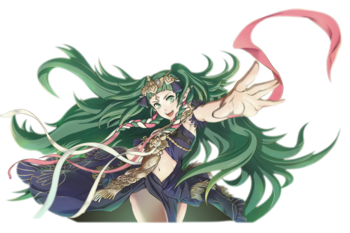
A mysterious entity who lives within Byleth's mind, Sothis is worshiped as the goddess and creator of the continent of Fódlan by the Church of Serios. With powers over time and a sassy personality, she works with Byleth as their Spirit Advisor and personal traveling companion. In Byleth's reveal trailer, she is the one who gives them their invitation envelope, and grants them access to the three lords' Heroes' Relics. In the game proper, she assists in Byleth's Final Smash by giving them her progenitor goddess powers to unlock the Sword of the Creator's true power and lay waste to their foes with the Sublime Heaven technique. She also serves as a Legend-classed Support Spirit that comes with the Spirit Board bundled with Byleth's DLC pack.
- Antiquated Linguistics: Her speech patterns are fancier and more archaic than her young appearance would suggest them to be.
- Ascended Meme: In Byleth's trailer, Sothis acknowledges that adding yet another swordsman to the game adds little, so she grants them the three weapons held by the leaders of the eponymous Three Houses to make up for that.
- Audience Surrogate: Her reaction to more Fire Emblem swordsmen/women and how the Avatar character has both genders playable is one of annoyance — indeed, both have been done repeatedly in the series, and the audience wasn't impressed to see more of the same. Fortunately, she solves the problem by having Byleth go the Walking Armory route with additional relic weapons.Sothis: So you return, and sooner than expected. [annoyed] I see. Too many swordsmen, are there? And you? You wield the sword as well! [angrily slaps her palms on her throne's armrests] What will you do?!
- Bad with the Bone: In Byleth's trailer, Sothis smugly bestows them with the Heroes' Relics Areadbhar, Aymr, and Failnaught — a glaive, an axe, and a bow, respectively, made from dragon bones — in response to there being "[too] many swordsmen" in Smash.
- Cool Chair: Sothis is almost always seen sitting on the humongous stone Throne of Knowledge, which, according to Fódlan myth, is what Saint Seiros sat on in order to receive a divine revelation and blessing from Sothis herself.
- Deadpan Snarker: She responds to Male Byleth only using the Sword of the Creator in combat and his idea of changing tactics being to swap to Female Byleth with wry exasperation.
- Enigmatic Empowering Entity: Not much is known about her personal history from before she arrived to Fódlan and started being worshiped as the progenitor god, and myth describes her as the one who made the Sword of the Creator for the Liberation King Nemesis. In Smash, she is the one to give Byleth the house lords' Heroes' Relics, and she provides a power boost to Byleth in their Final Smash.
- Healing Hands: Her effect as a Support Spirit is a souped up Critical Health Healing, drastically healing the player's damage/stamina once it reaches a certain threshold.
- Meme Acknowledgement: Of the proliferation of "anime sword fighters" in Smash."I see... too many swordsmen, are there?"
- Meta Guy: She convinces Byleth to join Smash, is baffled by Byleth changing gender out the blue, and after Byleth gets trounced while just using the Sword of the Creator, she lampshades that Byleth is just another generic Fire Emblem sword fighter and uses this to justify granting Byleth the other Relic weapons.
- Older Than They Look: While she has the appearance of a child, she is actually older than recorded history.
- Physical God: She is worshipped by the Church of Seiros as the goddess who created Fódlan.
- Pointy Ears: As with fellow Fire Emblem characters Corrin and Tiki, they’re a sign of her draconian nature.
- Really 700 Years Old: While Sothis's exact age is unknown, she's well over thousands of years old, starkly contrasting with her childlike physical appearance.
- Sharing a Body: Sothis lives inside Byleth's mind, and if Byleth dies, so will she. As a result of sharing Byleth's body, Sothis can link minds with Byleth and grant them her powers, letting them transform into their Enlightened One form.
- Spirit Advisor: She often offers Byleth advice, and assists Byleth in their Final Smash by allowing them to use the Sword of the Creator's true power.
- Super-Empowering: For Byleth's Final Smash, she grants them the full extent of her power and changes them into their Enlightened One form.
- Time Master: She possesses the power of temporal manipulation, and her signature technique, the Divine Pulse, allows her and whoever she empowers to turn back time in order to undo mistakes and change future events.
- Tiny Tyrannical Girl: Sothis has the appearance of a young girl, but bosses Byleth around, is sharp-tongued, and throws the occasional tantrum. Despite her sassy attitude, she is an ancient goddess who played a key role in the foundation of Fódlan.
Other
The Announcer is precisely that. While the voice actor changes with every game, in each one they generally just belt out the names of the fighters and game modes, as well as declare the winners and results. This changed with 3DS/Wii U, where the then Announcer, Xander Mobus, had much more of a role in the advertising, with his acting as the host of the Super Smash Bros. for Wii U 50-Fact Extravaganza![]() and starred in the commercials for both versions of the game. Of note is that in every game, the Announcer shares his voice actor with Master Hand.
and starred in the commercials for both versions of the game. Of note is that in every game, the Announcer shares his voice actor with Master Hand.
- Animated Actors: While not animated per se, he asks someone offscreen during the Ultimate overview trailer if he gets paid overtime after noting that 74 fighters exist in the base game.
- Ascended Extra: Went from a memorable ham to a handy marketing tool for 3DS/Wii U.
- Breakout Character: Xander Mobus' tenure as the Announcer in 3DS/Wii U was extremely popular due to his charisma (both in-game and out) and his role in the marketing, to the point where the games would launch his career as a voice actor. Tellingly, he is the only Announcer to reprise his role in a later game.
- Large-Ham Announcer: Among the most famous in the history of video games, the four incarnations of the Announcer boast legendarily porky performances. Though Xander Mobus has become especially memetic, Pat Cashman deserves special mention for essentially having the same type of role he had for Bill Nye the Science Guy.
- Mr. Exposition: Xander Mobus for the 50-Fact Extravaganza, where he shows off 54 things that happen to be in the Wii U installment.
- Title Scream: For the first two games only, Jeff Manning in 64 and Dean Harrington in Melee yell the name of their respective installments at the top of their lungs at the end of the intro movies. Brawl has
 empty sound files with names suggesting that Pat Cashman was also supposed to continue the tradition. Xander Mobus also tweeted that he recorded himself yelling out the title, but for some reason, it was dummied out, though he does manage to carry it out for any Smash Direct or trailer that he gets to narrate.
empty sound files with names suggesting that Pat Cashman was also supposed to continue the tradition. Xander Mobus also tweeted that he recorded himself yelling out the title, but for some reason, it was dummied out, though he does manage to carry it out for any Smash Direct or trailer that he gets to narrate.
Ruling families of the two warring nations Hoshido and Nohr. They appear in Corrin's trailer coaxing him to joining each other's side only to be left astonished when Corrin chooses to join the battle in Smash instead, leaving both families behind.
- The Voiceless: Althogh they appear in Corrin's trailer, Hinoka, Takumi, Camilla, and Leo do not speak.
- What the Hell, Hero?: Xander calls Corrin out on his decision with the above quote.
An evil warlock who opposes the Church of Seiros and is part of a dark conspiracy that plans to plunge Fódlan into chaos. He appears in Byleth's trailer, casting a dark spell to banish them into a voidal prison, only for Sothis's gift of an invitation to Smash Bros. to foil his scheme.
- Adapted Out: Notably, while the beginning of Byleth's reveal trailer is a mostly identical recreation to when Solon tried to imprison Byleth in their home game, Solon's ally Kronya is absent, and he thus casts the spell of Zahras without needing to tear out Kronya's heart to use as fuel.
- Black Eyes of Crazy: He has black sclera and white irises, adding to his Obviously Evil appearance.
- Casting a Shadow: It comes with the territory of being a Dark Mage. He attempts to use the forbidden spell of Zahras to drag Byleth into an endless dark void, causing a whirlwind of darkness to envelop and imprison them. It doesn't take.
- Jaw Drop: Once Byleth breaks out of his prison again, this time as a woman, and flies off with the Heroes' Relics, he can only stare in confusion and shock with his mouth agape.
- Mad Eye: In addition to having black sclera and white irises, his right eye is held wide open, giving him a deranged appearance.
- My Brain Is Big: His forehead is huge and has veins bulging out of it, a sign of his intelligence as a Mad Scientist.
- Oh, Crap!: His expression when Byleth escapes from his trap (twice!) says it all.
- Undeathly Pallor: His skin is pitch white, a trait that he shares with his fellow members of those who slither in the dark.

